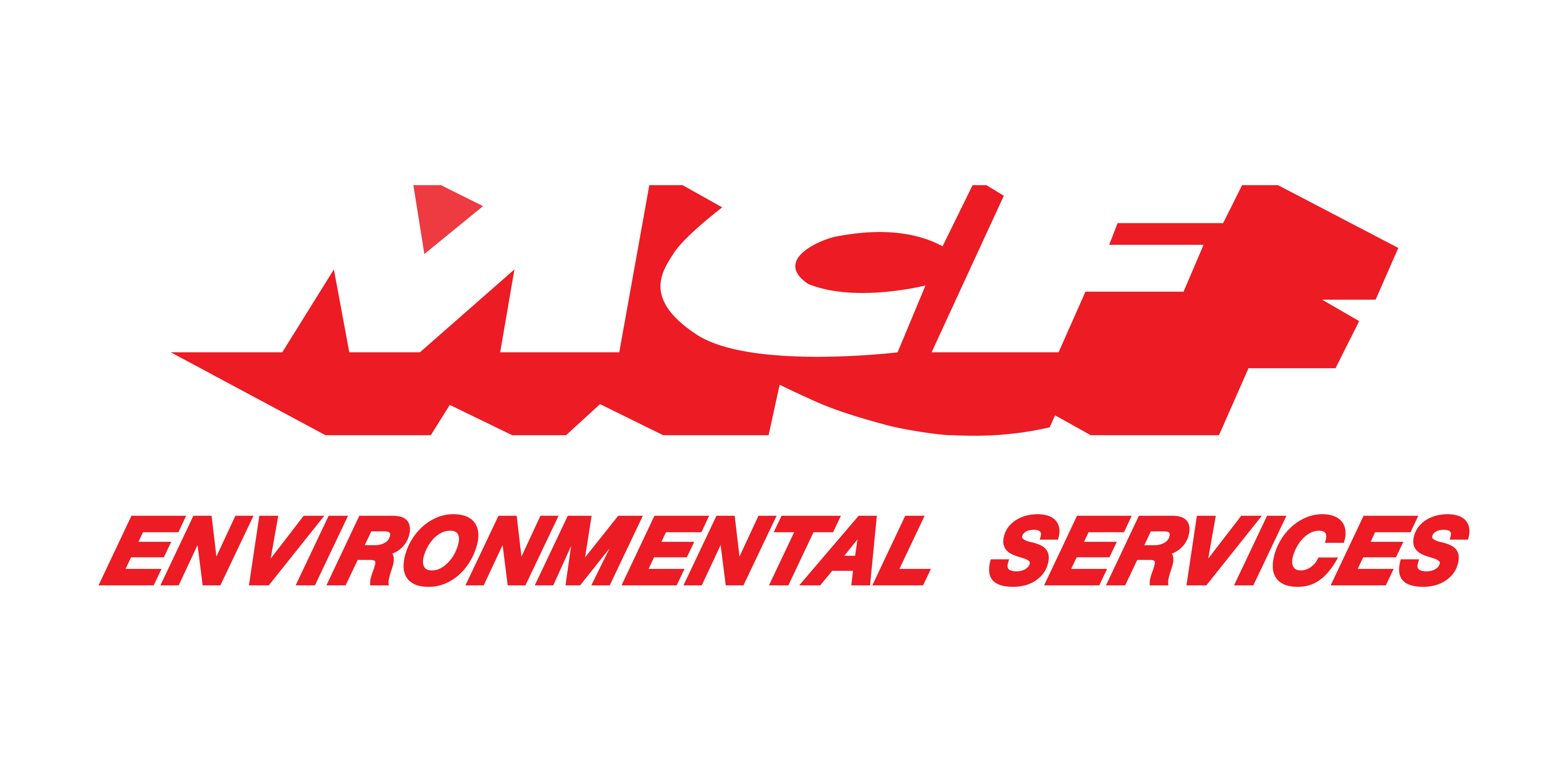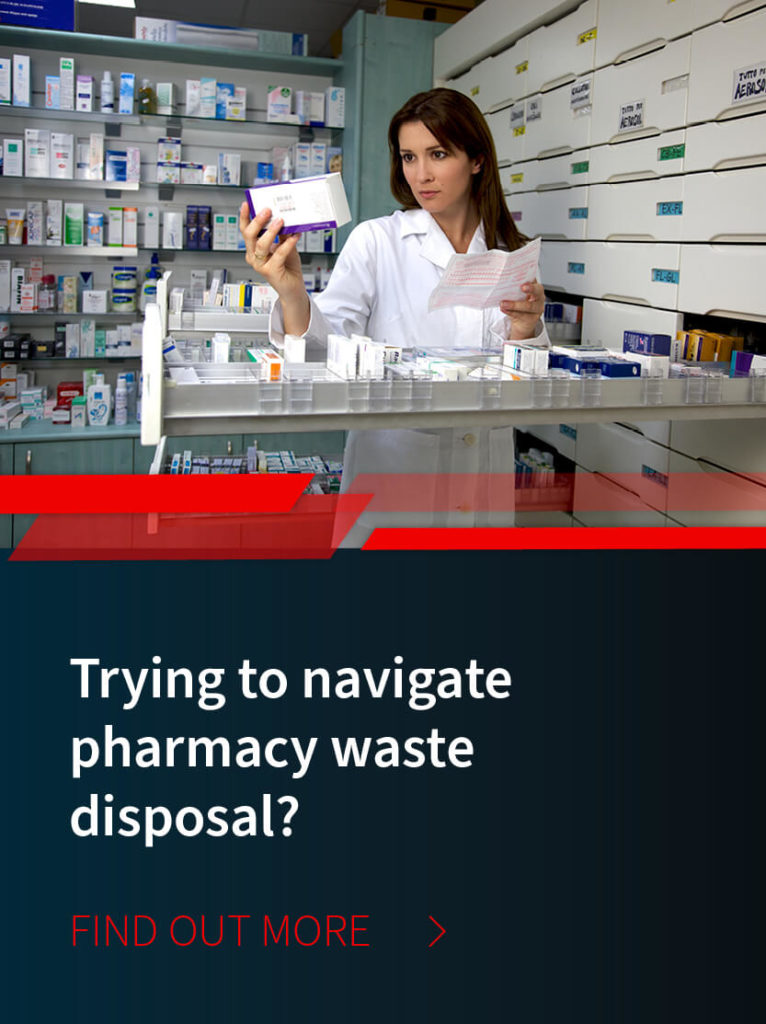
/ IN THIS BLOG
Proper pharmaceutical waste disposal is a critical part of running a safe, compliant pharmacy. Expired medications can pose serious health and environmental risks if mishandled, and pharmacies that fail to follow local, state, and federal disposal rules can face steep fines, reputational damage, and legal consequences.
The National Community Pharmacists Association (NCPA) estimates about 250 million pounds of unused medications are improperly disposed of each year. From controlled substances to hazardous and non-hazardous medications, each waste type comes with its own rules. And while it may seem straightforward, managing these requirements internally can quickly become overwhelming without a clear plan in place.
That’s why it’s helpful to have an organized process, with step-by-step actions, to ensure expired medications are disposed of properly. Whether you manage a small pharmacy or operate as part of a larger healthcare system, these practices reduce liability, protect both staff and patients, while ensuring compliance at every stage of the disposal process.
01 / Step 1: Identify the Pharmacy Waste
The first and most important step in dealing with expired medication disposal is to know exactly what you’re dealing with. Not all pharmaceutical waste is created equal and without proper identification, it’s impossible to apply the correct storage, transport, and treatment protocols.
Expired medications generally fall into one of three regulatory categories:
Hazardous Waste:
Non-Hazardous Waste:
Controlled Substances:
It’s important to remember that some medications can fall into more than one category and this can further complicate classification.
Many pharmacies turn to Safety Data Sheets (SDS), manufacturer documentation, and DEA schedules to make determinations. Others rely on their trusted pharmaceutical waste service provider, who can offer compliance expertise and can assist with classification. This helps to reduce the risk of misidentification and subsequent costly violations and is especially helpful for busy or understaffed pharmacies.
02 / Step 2: Segregate and Store Properly
Once expired medications are identified, the next critical step is segregating each waste stream according to its classification. Hazardous waste, non-hazardous pharmaceutical waste, and controlled substances must each be stored in separate, clearly labeled containers that meet regulatory requirements.
Key considerations include:
Hazardous pharmaceutical waste must be stored in containers that are leak-proof, compatible with the waste type, and labeled with accumulation start dates and appropriate hazard warnings.
Non-hazardous pharmaceutical waste should also be clearly marked and stored securely to prevent cross-contamination or misuse.
Controlled substances require secure storage in locked, tamper-proof containers with limited access, following DEA guidelines for inventory tracking and disposal.
Sharps and biomedical waste, such as used syringes or vials, must never be mixed with expired medications. These require their own containers and are subject to separate disposal regulations.
Improper segregation is one of the most common pharmacy compliance issues. Having a structured storage plan, which includes training staff to follow it, minimizes risks, ensuring waste is prepared for compliant transport and treatment.
03 / Step 3: Understand Regulatory Responsibilities
Pharmaceutical waste disposal is governed by multiple regulatory bodies, each with specific requirements that pharmacies must follow. These include:
EPA (Environmental Protection Agency): Oversees hazardous waste under RCRA (Resource Conservation and Recovery Act), including the proper handling, storage, and disposal of hazardous pharmaceuticals.
DEA (Drug Enforcement Administration): Regulates the storage, tracking, and destruction of controlled substances.
DOT (Department of Transportation): Sets requirements for packaging and transporting hazardous materials.
OSHA (Occupational Safety and Health Administration): Ensures worker safety, including proper training and handling procedures for hazardous waste.
Each agency has its own documentation, training, and procedural standards. For example, the EPA’s Subpart P regulations require certain healthcare facilities to follow specific hazardous waste management practices, including prohibiting the sewering of hazardous pharmaceuticals.
Understanding which regulations apply to your pharmacy is essential, especially as generator status, facility type, and waste volume can impact compliance requirements. Many pharmacies choose to work with an experienced waste service provider to help them navigate overlapping rules and maintain full compliance while avoiding overburdening internal teams.
04 / Step 4: Choose the Right Containers and Labels
Once expired medications are properly identified and segregated, they must be stored in appropriate containers that meet regulatory requirements. Improper storage is a common source of violations and can pose serious health and environmental risks.
Containers used for pharmaceutical waste must be:
Compatible with the type of waste
Clearly labeled with contents, hazard class, and accumulation start date
Sealed when not actively being filled
DOT-approved for any waste that will be transported
Controlled substances require secure, locked storage and may involve on-site witness protocols during destruction or handoff to a reverse distributor. Hazardous pharmaceutical waste must be stored in containers that prevent leaks, spills, and vapor release. Red bags or sharps containers should never be used for expired medication disposal unless specified by regulation for specific waste types.
Proper labeling and storage not only ensure regulatory compliance but also make internal processes more efficient and safe. This is an area where a waste management service experienced in pharmacy waste can assist with. At MCF Environmental, for example, we help our pharmacy clients evaluate their current container setup and provide compliant solutions tailored to each pharmacy’s waste profile.
05 / Step 5: Understand Storage and Disposal Timelines: How to Dispose of Expired Medication
Expired medications can't sit on your shelves indefinitely. Even if it’s stored in the correct containers, there are requirements for when it needs to be removed from a pharmacy location. The amount and type of pharmaceutical waste your pharmacy generates determines how long it can be stored before disposal is required.
Under the RCRA, pharmacies are categorized by generator status:
Very Small Quantity Generators (VSQGs): Generate less than 220 pounds of hazardous waste/month
Small Quantity Generators (SQGs): 220–2,200 pounds/month
Large Quantity Generators (LQGs): More than 2,200 pounds/month
Each category comes with different storage time limits:
VSQGs and SQGs generally have 180 days to dispose of waste
LQGs must dispose of waste within 90 days
Exceeding these timelines can result in significant fines and regulatory scrutiny. Timely disposal also prevents accumulation that could lead to safety hazards or storage issues.
This is one of the easiest ways to slip out of compliance and many pharmacies benefit from scheduling routine pickups with a qualified disposal partner to avoid gaps and keep operations running smoothly.
06 / Step 6: Complete the Proper Paperwork
Pharmaceutical waste disposal requires more than just proper identification and containers. Your pharmacy will also need to complete accurate documentation. These records are essential to prove compliance and protect your pharmacy from liability.
Key documentation includes:
Waste profiles: Descriptions of each waste stream to determine disposal method
Shipping manifests: Legal documents that track hazardous waste from pickup to final disposal
Certificates of destruction: Proof that waste was treated and disposed of according to regulations
Employee training records: Verification that staff are properly trained on waste handling
For controlled substances, additional paperwork is required under DEA regulations, including use of DEA Form 41 for destruction and chain-of-custody records to prevent diversion.
Errors or gaps in documentation can result in failed inspections, lost certifications, or even legal action. Many pharmacies reduce this risk by working with a licensed waste service provider who can manage paperwork accurately and provide a complete audit trail.
07 / Step 7: Train Pharmacy Staff on Waste Compliance
Even the best waste management plan can fall apart without proper training and buy-in from the entire pharmacy team. Every pharmacy employee who handles, stores, or disposes of expired medication must understand the rules and procedures required for compliance.
Training should include:
How to identify different waste types (hazardous, non-hazardous, controlled substances)
Use of compliant containers and storage protocols
Steps for reporting spills or incidents
Regulatory requirements from the EPA, DEA, OSHA, and DOT
Pharmacies are subject to inspections, and regulators often ask to see documentation proving that staff receive regular training. This isn’t a one-time event. Instead, this type of training should be approached as an ongoing process that will evolve as staff roles shift or regulations change.
Partnering with an experienced waste service company can simplify the training process. MCF Environmental is proud of the guidance we offer clients, which includes audits, resource and training materials, onsite walkthroughs, and virtual sessions tailored to each pharmacy’s unique needs.
08 / Step 8: Find a Reliable Licensed Waste Services Provider
Managing expired medications comes with complex regulations, shifting guidelines, and high stakes. Most pharmacies benefit from partnering with a highly-respected licensed pharmaceutical waste service provider that understands the compliance landscape and can streamline disposal from start to finish.
A qualified partner should:
Be licensed and insured for all waste types your pharmacy generates
Offer cradle-to-grave documentation for full liability protection
Support with profiling, manifesting, and regulatory reporting
Handle hazardous, non-hazardous, and controlled substances
Provide training or guidance as needed for staff
Choosing the right waste partner reduces the administrative burden on pharmacy teams while improving compliance, safety, and efficiency. With a trusted provider in place, pharmacy managers can stay focused on patient care and remain confident that their waste is being handled correctly.
Build a Safer, Compliant Pharmacy Waste Program
Pharmaceutical waste disposal is more than an occasional administrative task. It’s a critical part of protecting public health, the environment, and your business. With so many categories of expired medication and strict federal and state rules to follow, it’s easy to make mistakes, which can lead to costly penalties and reputational damage.
By following a structured process pharmacies can meet their legal obligations and remain fully compliant. But navigating all those steps can feel overwhelming and cumbersome, particularly if you manage a busy pharmacy.
A full-service pharmaceutical waste partner like MCF Environmental Services can make all the difference. From profiling your waste to providing regulatory support, MCF helps pharmacies build smart, compliant disposal systems that reduce risk and liability.
Need help getting started? Contact MCF Environmental Services to build a pharmaceutical waste program that protects your people, your patients, and your bottom line.
Robert Losurdo
President, COO








